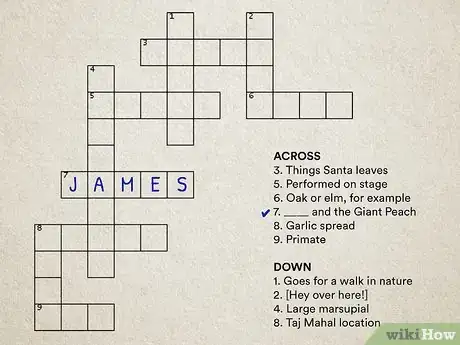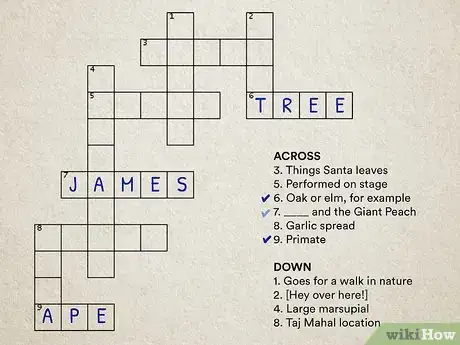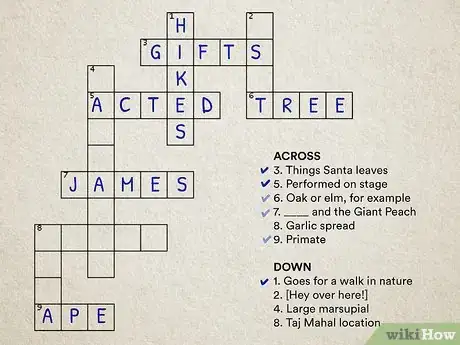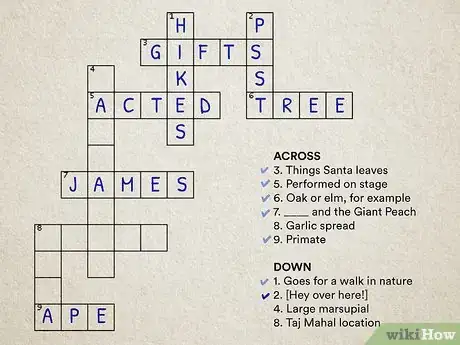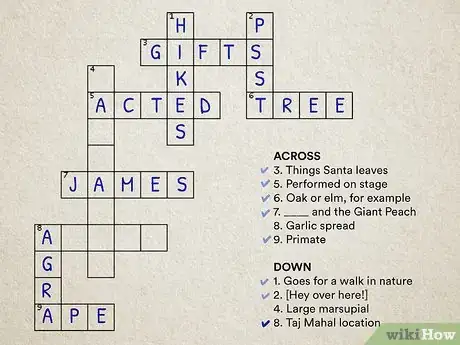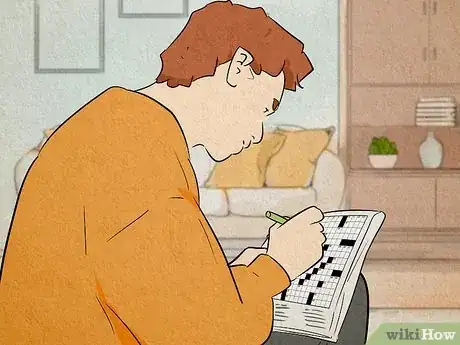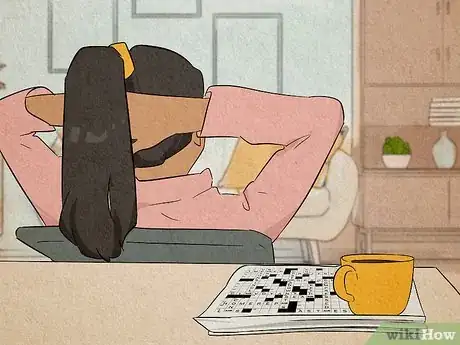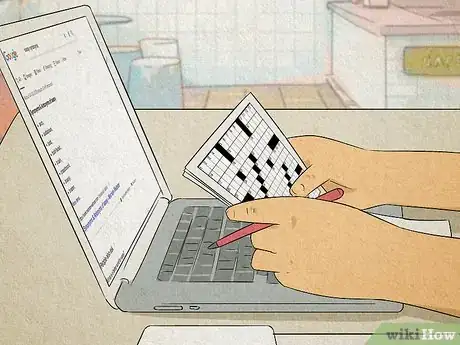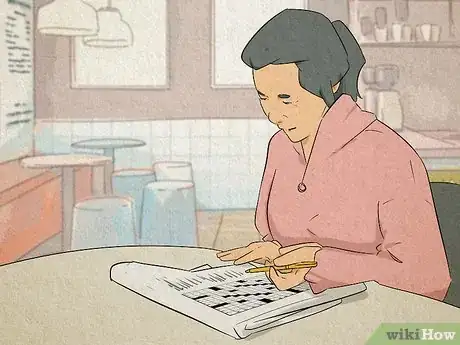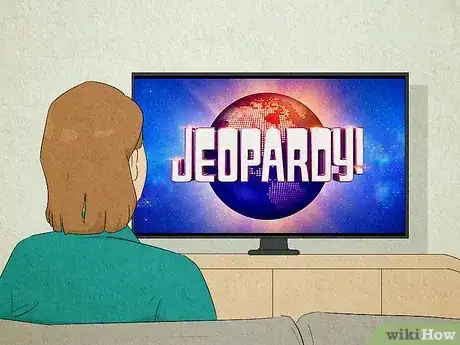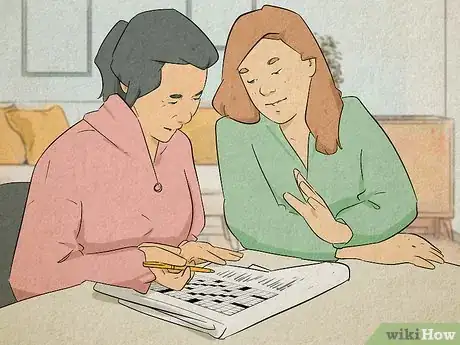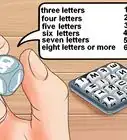This article was co-authored by wikiHow staff writer, Hunter Rising. Hunter Rising is a wikiHow Staff Writer based in Los Angeles. He has more than three years of experience writing for and working with wikiHow. Hunter holds a BFA in Entertainment Design from the University of Wisconsin - Stout and a Minor in English Writing.
This article has been viewed 20,964 times.
Learn more...
Have you ever started a crossword puzzle but struggled to finish some of the words? Crosswords are a challenging way to tickle your brain, and solving them is a skill you can easily improve so you keep getting better. Luckily, you can use the same tricks on any crossword puzzle that you’re working on. Keep reading for all the best strategies to use when you’re solving a crossword puzzle so you can fill in the entire grid!
Steps
Tackle fill-in-the-blanks first.
-
These clues tend to be easier to fill in than others. Rather than starting with the first clue and going in order, scan through all of the clues and look for some easy “gimmes.” Fill-in-the-blank clues are usually common knowledge, so you should have an idea of what the right answer is. After you get a few of the easy words in, you’ll feel a big boost of confidence going forward. Some example clues could be:[1] X Research source
- “____ Lisa (famous painting)” for MONA
- “Costa ____” for RICA
- “ ____ and the Giant Peach” for JAMES
- “Do re mi fa __” for SOL
Fill in 3- and 4-letter words you know.
-
Short words are usually simpler to solve than the longer answers. While some short words might be more challenging, you still have a good chance of finding a few that you can answer. Look through the crossword puzzle for shorter words and check the clue to see if you know the answer. Filling in the shorter answers first can give you some extra letters to help you solve longer words. Some clues could be:[2] X Research source
- “Primate” for APE
- “Pig’s home” for STY
- “Oak or elm, for example” for TREE
- “Chocolate and cream cookie” for OREO
Check the tense and number in the clues.
-
The answers in the puzzle will match the tense and number in the clue. Even if you don’t know the exact word for the clue, you can make assumptions based on how the clue is written. If a clue is in the past, present, or active tense, or if it’s singular or plural, then you know what the last few letters of the answer might be.[3] X Research source
- Past tense clues tend to end with -ED, like “Performed on stage” for ACTED.
- Present tense clues usually end in S, like “Goes for a walk in nature” for HIKES.
- Clues with an -ING verb tend to end the same way, such as “Leaving” for GOING.
- Many plural clues end in the letter S, like “Things Santa leaves” for GIFTS.
Look for formatting hints in the clues.
-
Punctuation and add-ons in the clues tell you how the answer is formatted. Since crossword constructors want to give you a challenge, they may try to play a few tricks on you that are easy to catch. Break down the clue and look for these parts to get an idea of how the answer might appear.[4] X Research source
- Abbreviations in the clue or “abbr.” mean the answer is abbreviated, like “Stat. for a pitcher” for ERA.
- Question marks always mean the clue has wordplay or is trying to mislead you. “Flower?” could mean “something that flows” and be a clue for RIVER.
- The term “in” followed by a city usually means a foreign word, like “Boy, in Barcelona” for NINO.
- Words in brackets mean the answer is a sound, like “[Hey over here!]” for PSST.
Familiarize yourself with common crossword answers.
-
Short words with lots of vowels tend to show up in multiple puzzles. Since the words on a crossword puzzle need to intersect, constructors rely on some less-common words that contain a lot of vowels. You might not know the definition from the clue, but you can usually work it out from the surrounding words and remember the definition for future puzzles. Common answers (and their possible clues) can be:[5] X Research source
- EPEE (“Fencing sword”)
- AIOLI (“Garlic spread”)
- AGRA (“Taj Mahal location”)
- BEE, CEE, or DEE (“Common letter grade”)
- Puzzles may also use compass directions, like ESE, ENE, NNE, or SSE.
Check intersecting words when you guess an answer.
-
Putting a guess in might help you figure out words that cross through it. If you’re not positive about a word but have an idea for what an answer might be, write it in the grid lightly in pencil. Check the clues surrounding the word to see if there are any answers that fit with those letters. If you notice that your answer doesn’t work with other answers nearby, you can just erase it and come back to it later.[6] X Research source
Jump around to different parts of the puzzle.
-
You’ll fill in more words if you look for sections that are easier to solve. If you’re caught up in one section of the puzzle, don’t feel like you have to keep working on that spot. Feel free to look through the clues again and find an area where you can start filling in more letters. You can always come back to the other spot later.[7] X Research source
Take a break if you’re struggling.
-
You’ll come back with fresh eyes and may catch words you missed. When you’re tired or have been looking at the puzzle for a while, you may not think through the answers clearly. Rather than getting more frustrated staring at the grid, set it aside and do something else for a little while. Give your brain a chance to rest and pick up where you left off once you’ve cleared your head.[8] X Research source
Look answers up if you can’t solve them on your own.
-
Searching for an answer helps you learn the word for the future. Look at the answer key or look up the crossword clue online to find the answer you’re missing. You shouldn’t feel bad if you need to look up an answer even if it’s something you think you should already know. Checking the answer actually makes it stick in your mind for longer, so you may be able to remember it for another puzzle.[9] X Research source
Start with easier crossword puzzles.
-
Work your way up so you don’t struggle with difficult puzzles. If you start with the toughest puzzles you can find, it’ll be more of a struggle if you don’t already know some tricks for solving them. Instead, look for websites or crossword books that offer easy puzzles so you can get used to solving them. Themed puzzles are easier since some of the answers have something in common.[10] X Research source
- Magazines like People have easy crosswords with more clues based on pop culture.
- Most print publications, like The New York Times and The New Yorker, publish the easiest puzzles on Mondays and they get progressively harder throughout the week.
Try solving a puzzle every day.
-
Practice daily so you can keep improving your solving skills. It takes a bit of time and practice to catch on to all the little quirks in crossword puzzles, so make puzzling a part of your routine. Take a few minutes in the morning or at night to sit down and work through a crossword puzzle. As you do more puzzles, the quicker you’ll be able to finish them and recognize common patterns.[11] X Research source
Play other word and trivia games.
-
Crosswords use a ton of general knowledge and pop culture references. Testing your knowledge with other games is a great way to remember common facts and trivia. Take time to watch Jeopardy!, play a game of Trivial Pursuit, or try to figure out the Wordle for the day. Even just reading more in your free time can help you recognize more vocabulary that a puzzle could use.[12] X Research source
Work on crossword puzzles with your friends.
-
You can bounce ideas off of each other to help speed up your solving time. If you don’t want to work on the puzzle alone, see if any of your other friends like to do crosswords. Sit together and ask questions about clues that you’re not sure of. They may be able to help you work through tough spots and you can help with words they don’t know too.[13] X Research source
You Might Also Like
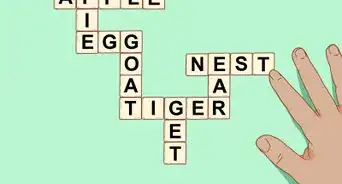 How to Set Up and Play Bananagrams
How to Set Up and Play Bananagrams
 Beat Wordle Every Time: The Best 5-Letter Words & Tricks
Beat Wordle Every Time: The Best 5-Letter Words & Tricks



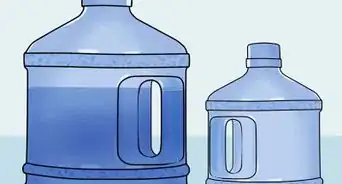
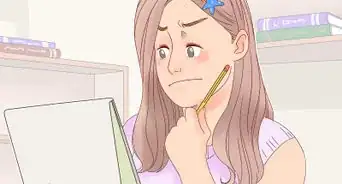

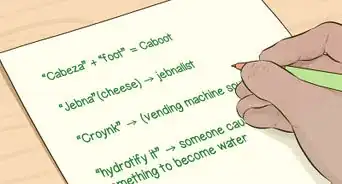

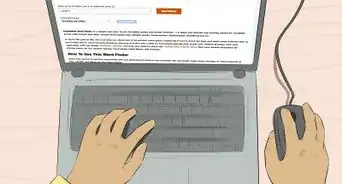 12 Strategies to Win Words with Friends Every Time
12 Strategies to Win Words with Friends Every Time
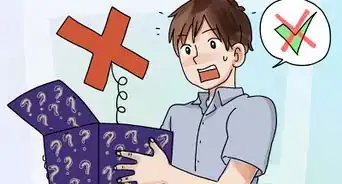
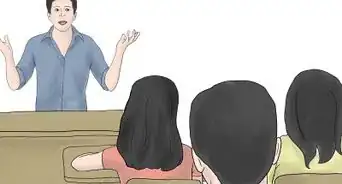
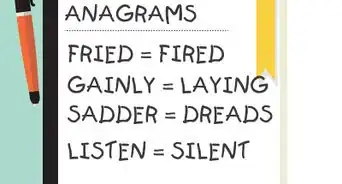
References
- ↑ http://www.thepuzzleplayer.com/tips-on-how-to-become-better-at-crosswords/
- ↑ http://www.thepuzzleplayer.com/tips-on-how-to-become-better-at-crosswords/
- ↑ https://yourpuzzlesource.com/ten-tips-to-help-you-solve-crosswords-like-a-puzzle-master/
- ↑ https://yourpuzzlesource.com/ten-tips-to-help-you-solve-crosswords-like-a-puzzle-master/
- ↑ https://yourpuzzlesource.com/ten-tips-to-help-you-solve-crosswords-like-a-puzzle-master/
- ↑ https://yourpuzzlesource.com/ten-tips-to-help-you-solve-crosswords-like-a-puzzle-master/
- ↑ https://yourpuzzlesource.com/ten-tips-to-help-you-solve-crosswords-like-a-puzzle-master/
- ↑ https://www.psychologytoday.com/us/blog/changepower/201302/how-is-doing-crossword-puzzle-changing-habit
- ↑ https://www.psychologytoday.com/us/blog/changepower/201302/how-is-doing-crossword-puzzle-changing-habit
- ↑ https://www.thereflector.com/stories/improve-crossword-solving-skills,33926
- ↑ http://www.thepuzzleplayer.com/tips-on-how-to-become-better-at-crosswords/
- ↑ https://www.thereflector.com/stories/improve-crossword-solving-skills,33926
- ↑ https://www.psychologytoday.com/us/blog/changepower/201302/how-is-doing-crossword-puzzle-changing-habit
About This Article

